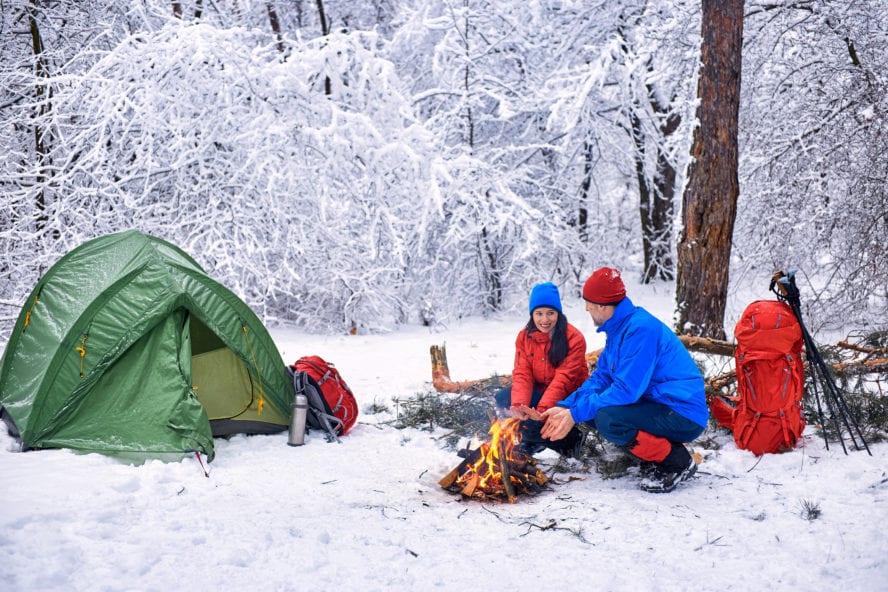Uncategorized
Essential Gear for Winter Camping: Stay Warm and Safe
Winter camping is a unique and exhilarating way to experience the outdoors. The crisp air, snowy landscapes, and the peace of a winter wilderness can make for an unforgettable adventure. However, the colder temperatures and harsher conditions require careful planning and the right gear to ensure you stay safe and comfortable. In this guide, we’ll go over the essential gear you need for winter camping to stay warm, dry, and safe while enjoying the winter wilderness.
1. Winter Sleeping Bag
A winter sleeping bag is one of the most critical pieces of gear for staying warm while camping in cold weather. A regular sleeping bag might not be insulated enough to handle freezing temperatures, which can lead to discomfort or even hypothermia.
- Temperature Rating: Choose a sleeping bag rated for temperatures lower than what you expect during your trip. If you’re camping in temperatures that dip below freezing, a sleeping bag rated for 0°F to -20°F (-18°C to -29°C) is ideal.
- Insulation: Down insulation provides warmth and compressibility but can lose its insulating power when wet. Synthetic insulation, on the other hand, performs better in wet conditions and retains warmth even when damp. Choose the insulation type that suits your preferences and climate.
- Additional Warmth: Consider a sleeping bag liner or an extra insulating liner to add warmth without adding much weight.
2. Four-Season Tent
A four-season tent is designed to withstand the harsher conditions of winter camping. Unlike three-season tents, which are meant for spring, summer, and fall, four-season tents are built to handle snow, strong winds, and extreme cold.
- Durability: A four-season tent will have sturdier poles and a more robust frame to handle snow loads and strong gusts of wind. It should also have a thicker, more weather-resistant canopy and a full-coverage rainfly.
- Ventilation: Despite being built for harsh weather, winter tents need adequate ventilation to prevent condensation from building up inside. Look for a tent with adjustable vents or windows that can be closed during storms.
- Weight and Size: Four-season tents tend to be heavier than three-season tents due to their added durability. Choose a tent that fits your group size and offers enough space for comfort, but also consider the weight for backpacking trips.
3. Winter Sleeping Pad
Your sleeping pad serves as an essential barrier between you and the cold ground, providing insulation from the cold and adding comfort for a good night’s rest.
- R-Value: The R-value of a sleeping pad measures its insulation properties. For winter camping, look for a sleeping pad with a high R-value (around 5 or higher) to provide ample warmth from the ground.
- Type: Inflatable sleeping pads are compact and provide good insulation, but make sure to choose one specifically designed for winter camping. Foam pads are bulkier but offer excellent insulation and durability in extreme conditions. Combining both an inflatable and foam pad can offer extra warmth.
4. Warm Clothing Layers
Proper layering is key to staying warm and dry during winter camping. You’ll want to wear clothes that can handle moisture, retain heat, and allow for ventilation when you’re active. Here’s a breakdown of the essential clothing layers for winter camping:
- Base Layer: Start with a moisture-wicking base layer made of merino wool or synthetic fabrics. Avoid cotton, as it retains moisture and loses its insulating properties when wet. Base layers should include both top and bottom garments.
- Mid-Layer: For insulation, wear a fleece jacket or down/synthetic jacket. These layers trap heat while still allowing moisture to escape.
- Outer Layer: Your outer layer should be a windproof and waterproof jacket or shell. Gore-Tex or similar breathable fabrics work well for keeping wind, snow, and rain at bay while allowing sweat to evaporate.
- Accessories: Don’t forget warm socks, a hat, gloves, and neck gaiter or balaclava. Look for materials that wick moisture and provide insulation, like merino wool or fleece.
5. Winter Boots
A good pair of winter boots is essential for keeping your feet dry, warm, and protected from the elements.
- Insulation: Look for boots that are specifically designed for winter use, with sufficient insulation to keep your feet warm in sub-freezing temperatures. Thinsulate or down insulation are common options.
- Waterproofing: Waterproof boots are essential for keeping snow and water from soaking your socks and freezing your feet. Look for boots with a waterproof membrane like Gore-Tex.
- Traction: Winter conditions can be slippery, so choose boots with good tread and traction to avoid slipping on icy terrain.
6. Cooking System
Cooking in winter conditions can be challenging due to the cold temperatures, which affect the performance of stoves and fuel. Here are some tips to ensure you can cook efficiently:
- Winter-Ready Stove: A liquid fuel stove (such as white gas) is often more reliable in extreme cold than an isobutane stove, which can struggle in freezing temperatures. Make sure the stove is designed for cold weather use.
- Fuel: Bring extra fuel, as cold temperatures can cause stoves to use more gas. Consider fuel bottles or canisters that are designed for winter use.
- Cookware: Lightweight titanium or stainless steel pots and pans are great options for winter camping, as they are durable and heat up quickly. Ensure your cookware can handle freezing temperatures without cracking.
7. Headlamp and Extra Batteries
During the winter, daylight hours are shorter, and you’ll likely be relying on your headlamp for much of your camp tasks. Choose a headlamp with adjustable brightness settings and a long battery life.
- Cold Weather Batteries: Cold temperatures can drain batteries quickly, so carry extra batteries and store them in a warm place (such as inside your jacket) to prevent them from freezing.
- Hands-Free Lighting: A headlamp allows for hands-free lighting, which is crucial when you need both hands to handle gear or cook.
8. Snow and Ice Gear
If you’re camping in a snowy or icy environment, you’ll need additional equipment for safety and navigation:
- Crampons or Microspikes: These devices attach to your boots and provide extra grip on icy terrain, preventing slips and falls.
- Snowshoes: If you’re trekking through deep snow, snowshoes will help distribute your weight and keep you from sinking too deeply.
- Ice Axe: For mountaineering or steep terrain, an ice axe is an essential tool for self-arresting and navigating safely on snow and ice.
9. Emergency and First Aid Kit
Winter conditions increase the risks of hypothermia, frostbite, and injury. Having a well-stocked first aid kit is essential. Ensure it includes items like blister pads, bandages, gauze, antiseptic wipes, and personal medications.
Additionally, bring an emergency shelter such as an emergency bivy sack or space blanket for extreme conditions. A multi-tool and a firestarter kit (waterproof matches, lighters, firesteel) are also vital for winter emergencies.
10. Snow Shelter (Optional)
In case you need to build a snow shelter, like an igloo or quinzee, make sure you have the tools and knowledge to do so. A snow shovel can help you dig out a shelter, and a snow saw might come in handy for cutting blocks.
Conclusion
Winter camping is a rewarding but demanding outdoor experience. With the right gear, you can stay warm, safe, and comfortable while exploring winter landscapes. From insulated sleeping bags and four-season tents to proper clothing layers and a winter-ready stove, these essentials will help you embrace the cold and enjoy your winter adventure. Always be prepared, know your limits, and respect the winter wilderness to ensure a safe and enjoyable experience. Stay warm, stay safe, and enjoy the beauty of the season!

